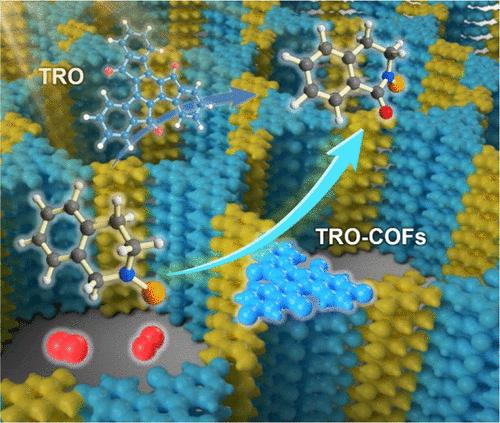当前位置:
X-MOL 学术
›
J. Am. Chem. Soc.
›
论文详情
Our official English website, www.x-mol.net, welcomes your
feedback! (Note: you will need to create a separate account there.)
Blending Aryl Ketone in Covalent Organic Frameworks to Promote Photoinduced Electron Transfer
Journal of the American Chemical Society ( IF 14.4 ) Pub Date : 2023-04-17 , DOI: 10.1021/jacs.3c01273 Mingjie Liu 1, 2 , Junnan Liu 1, 2 , Jing Li 1, 2 , Zhenghua Zhao 1, 2 , Kai Zhou 1, 2 , Yueming Li 1, 2 , Peipei He 1, 2 , Jiashu Wu 1, 2 , Zongbi Bao 1, 2 , Qiwei Yang 1, 2 , Yiwen Yang 1, 2 , Qilong Ren 1, 2 , Zhiguo Zhang 1, 2
Journal of the American Chemical Society ( IF 14.4 ) Pub Date : 2023-04-17 , DOI: 10.1021/jacs.3c01273 Mingjie Liu 1, 2 , Junnan Liu 1, 2 , Jing Li 1, 2 , Zhenghua Zhao 1, 2 , Kai Zhou 1, 2 , Yueming Li 1, 2 , Peipei He 1, 2 , Jiashu Wu 1, 2 , Zongbi Bao 1, 2 , Qiwei Yang 1, 2 , Yiwen Yang 1, 2 , Qilong Ren 1, 2 , Zhiguo Zhang 1, 2
Affiliation

|
Aryl-ketone derivatives have been acknowledged as promising organic photocatalysts for photosynthesis. However, they are limited by their photostability and have been less explored for photoinduced electron transfer (PET) applications. Herein we demonstrate a novel strategy to cover the shortage of aryl-ketone photocatalysts and control the photoreactivity by implanting symmetric aryl ketones into the conjugated covalent organic frameworks (COFs). To prove the concept, three comparative materials with the same topology and varied electronic structures were built, adopting truxenone knot and functionalized terephthalaldehyde linkers. Spectroscopic investigation and excited carrier dynamics analysis disclosed improvements in the photostability and electronic transfer efficiency as well as the structure–performance relationships toward N-aryl tetrahydroisoquinoline oxidation. This system provides a robust rule of thumb for designing new-generation aryl-ketone photocatalysts.
中文翻译:

在共价有机骨架中混合芳基酮以促进光诱导电子转移
芳基酮衍生物已被公认为用于光合作用的有前途的有机光催化剂。然而,它们受到光稳定性的限制,并且对光诱导电子转移 (PET) 应用的探索较少。在这里,我们展示了一种新策略,通过将对称芳基酮植入共轭共价有机骨架 (COF) 中来弥补芳基酮光催化剂的短缺并控制光反应性。为了证明这一概念,构建了三种具有相同拓扑结构和不同电子结构的比较材料,采用 truxenone 结和功能化对苯二甲醛连接体。光谱研究和激发载流子动力学分析揭示了光稳定性和电子转移效率以及结构-性能关系的改善N-芳基四氢异喹啉氧化。该系统为设计新一代芳基酮光催化剂提供了可靠的经验法则。
更新日期:2023-04-17
中文翻译:

在共价有机骨架中混合芳基酮以促进光诱导电子转移
芳基酮衍生物已被公认为用于光合作用的有前途的有机光催化剂。然而,它们受到光稳定性的限制,并且对光诱导电子转移 (PET) 应用的探索较少。在这里,我们展示了一种新策略,通过将对称芳基酮植入共轭共价有机骨架 (COF) 中来弥补芳基酮光催化剂的短缺并控制光反应性。为了证明这一概念,构建了三种具有相同拓扑结构和不同电子结构的比较材料,采用 truxenone 结和功能化对苯二甲醛连接体。光谱研究和激发载流子动力学分析揭示了光稳定性和电子转移效率以及结构-性能关系的改善N-芳基四氢异喹啉氧化。该系统为设计新一代芳基酮光催化剂提供了可靠的经验法则。































 京公网安备 11010802027423号
京公网安备 11010802027423号